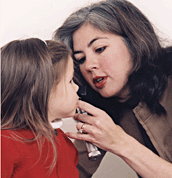Ear Infections, Hearing Loss
& Children
By Michelle Facer, DO
Otolaryngology
Northern Pines Ear, Nose & Throat, Eau Claire
If your child doesn’t pay attention to directions, seems slow to respond
to spoken requests, or has difficulty speaking, he may have a hearing
loss due to an ear infection. In fact, ear infections are very common
among young children. They are the second most common illness next to
the common cold and almost all children will experience at least one
infection before the age of three. Otitis media or inflammation of the
middle ear is the most common cause of hearing loss in children.
There are a couple of definitions of otitis media. These include acute
otitis media and otitis media with effusion. Acute otitis media (AOM)
commonly occurs after having a cold. In children, the eustachian tube
is shorter and more horizontally oriented and allows bacteria and viruses
to find their way more easily into the middle ear. The middle ear becomes
acutely infected with the rapid development of pain and fever. Younger
children may demonstrate irritability, fussiness, or difficulty sleeping
or feeding. There is a pus-like fluid present behind the eardrum in
the middle ear. The presence of this pus behind the eardrum leads to
temporary hearing loss. The average hearing loss in ears with fluid
is 24 decibels or the equivalent of wearing ear plugs. Hearing loss
can lead to difficulties with language development and learning. The
standard therapy for acute otitis media is antibiotics. More than 30
million prescriptions are written each year for ear infections, accounting
for 25 percent of all antibiotics prescribed in the United States. Antibiotics
help to prevent the possible serious complications of untreated otitis
media. Other medications that may be prescribed include decongestants,
antihistamines, or analgesic ear drops. Some children are prone to recurrent
ear infections. Otitis media is more common in children between 6 months
and 3 years of age. By age 3, more than two-thirds of children have
had one or more episodes of otitis media, and one third have had more
than three episodes. Recurrent episodes of AOM (more than 3 episodes
in 6 months or more than 4 episodes in 12 months) is an indication for
surgery.
Otitis media with effusion (OME) is defined as the presence of middle
ear fluid for 6 weeks or longer from the initial acute otitis media.
With OME there is watery or mucous-like fluid in the middle ear, which
can cause mild to moderate hearing loss for weeks or even months. There
are no signs or symptoms of active ear infection, but there may be significant
hearing loss or balance disturbances. Children attending day care are
more likely to have OME than children who are not in day care. Tonsil
and adenoid problems can also cause ear problems. Allergies can also
be an underlying factor contributing to OME. More than 75% of OME will
resolve spontaneously within 3 months time. Physicians will occasionally
prescribe antibiotics to attempt to resolve the fluid. Control of risk
factors such as pacifier use, day care exposure, tobacco smoke exposure,
and allergies are advocated. A hearing test is suggested when fluid
has been present for 3 months or longer. If hearing loss is present
in both ears and is significant (greater than 30 decibels), surgery
is recommended. Surgery is also recommended if the child develops recurrent
episodes of acute otitis media.
What happens if surgery (myringotomy and tubes) needs to be performed?
The child’s primary care physician will refer the family to an
Otolaryngologist -- an Ear, Nose and Throat specialist. A complete exam
and hearing evaluation will be completed and all options will be discussed
with the family. If the decision is made to proceed with surgery, the
procedure is described in detail to the family. Myringotomy involves
a small surgical incision in the eardrum to promote drainage of fluid
and relief of pain. A small tube is placed in the incision to prevent
fluid re-accumulation and to thus improve hearing. Tubes usually decrease
the frequency and severity of infections, but will not eliminate infections
completely. The tubes tend to remain in place for 6 months to several
years. Most tubes fall out on their own. If the child has underlying
tonsil and adenoid problems, this issue may also be addressed at the
time of myringotomy and tube insertion.
So, remember that acute otitis media is generally not serious if treated
promptly and properly. Options include both medical and surgical management
depending on the frequency of infections, the amount of hearing loss,
and the wishes of the patient and family. Finally, if there is any concern
that your child has a hearing loss, be sure to discuss this with your
physician and to pursue the recommended testing and follow-up.
Symptoms of ear infections:
Infants and toddlers:
- pulling or scratching at the ear
- hearing problems
- crying, irritability
- fever
- vomiting
- ear drainage
- fever
Young children, adolescents, and adults
- earache
- feeling of fullness or pressure
- hearing problems
- dizziness, loss of balance
- nausea, vomiting
- ear drainage
For more information, call Dr. Facer, Otolaryngology
at Northern Pines Ear, Nose & Throat » 715.830.9990 www.northernpinesent.com





